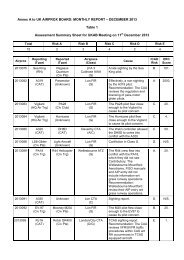STATISTICS 2016
DUKES_2016_FINAL
DUKES_2016_FINAL
Create successful ePaper yourself
Turn your PDF publications into a flip-book with our unique Google optimized e-Paper software.
Technical notes and definitions<br />
I Units and measurement of energy<br />
Units of measurement<br />
1.29 The original units of measurement appropriate to each fuel are used in the individual fuel<br />
chapters. A common unit of measurement, the tonne of oil equivalent (toe), which enables different<br />
fuels to be compared and aggregated, is used in Chapter 1. In common with the International Energy<br />
Agency and with the Statistical Office of the European Communities, the tonne of oil equivalent is<br />
defined as follows:<br />
1 tonne of oil equivalent = 10 7 kilocalories<br />
= 396.83 therms<br />
= 41.868 Gigajoules (GJ)<br />
= 11,630 Kilowatt hours (kWh)<br />
This unit should be regarded as a measure of energy content rather than a physical quantity. One<br />
tonne of oil is not equal to one tonne of oil equivalent.<br />
Thermal content - energy supplied basis of measurement<br />
1.30 Tables 1.1 to 1.3, 1.8 and 1.1.1 to 1.1.5 (available on the BEIS section of GOV.UK at:<br />
www.gov.uk/government/statistics/energy-chapter-1-digest-of-united-kingdom-energy-statistics-dukes<br />
are compiled on an energy-supplied basis. Detailed data for individual fuels are converted from<br />
original units to tonnes of oil equivalent using gross calorific values and conversion factors appropriate<br />
to each category of fuel. The results are then aggregated according to the categories used in the<br />
tables. Gross calorific values represent the total energy content of the fuel, including the energy<br />
needed to evaporate the water present in the fuel (see also paragraph 1.54).<br />
1.31 Estimated gross and net calorific values for 2015 are given in Table A.1 in Annex A. Calorific<br />
values are reviewed each year in collaboration with the fuel industries, and figures for earlier years<br />
can be found in Table A.2 and A.3. To construct energy balances on an energy supplied basis<br />
calorific values are required for production, trade, and stocks, as follows:<br />
Coal The weighted average gross calorific value of all indigenous coal consumed is used to derive<br />
the thermal content of coal production and undistributed stocks. Thermal contents of imports and<br />
exports allow for the quality of coal. Thermal contents of changes in coal stocks at secondary fuel<br />
producers are the average calorific values of indigenous coal consumed.<br />
Petroleum Work carried out in 1997 to revise calorific values for petroleum products did not find any<br />
recent work on the subject. In the absence of such work, the gross calorific values, included in Annex<br />
A and used in the construction of these energy balances from 1990 onwards, have been calculated<br />
using a formula derived by the US Bureau of Standards. This formula estimates the gross calorific<br />
value of products according to their density as follows:<br />
2<br />
GJ 51.83<br />
8.78<br />
d , where d is the density of the product in terms of kilograms per litre.<br />
For crude petroleum and refinery losses, the weighted average calorific value for all petroleum<br />
products from UK refineries is used. A notional figure of 42.9 GJ per tonne is used for non-energy<br />
petroleum products (industrial and white spirits, lubricants, bitumen, petroleum coke, waxes and<br />
miscellaneous products).<br />
Gases Although the original unit for gases is the cubic metre, figures for gases are generally<br />
presented in the fuel sections of this Digest in gigawatt hours (GWh), having been converted from<br />
cubic metres using gross calorific values provided by the industries concerned. Conversion factors<br />
between units of energy are given on the flap inside the back cover and in Annex A.<br />
Electricity and heat Unlike other fuels, the original unit used to measure electricity and heat is a<br />
measure of energy. The figures for electricity and heat can therefore be converted directly to toe<br />
using the conversion factors on the flap inside the back cover and in Annex A.<br />
20







